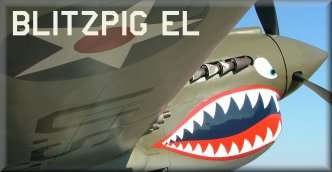
 |
|
#1151
|
|||
|
|||
|
Quote:
Anyway, one day it'll be implemented, I'm sure Best regards and thanks for the quick reply. Hope everything is going well in the testing of the 4.10. |
|
#1152
|
|||
|
|||
|
Hello team daidalos, i like the work you've done for il2.
But theres a thing that i noticed when flying the SM79: it turns like a spitfire. I think this isnt accurate, maybe this needs a fix from the upcomming patch. thanks |
|
#1153
|
|||
|
|||
|
Well, indeed, most aeroplanes turn exactly like the Spitfire: when wings are not level, you pull the stick and move the elevators. Result = a turn. I really can't see how this is not accurate. SM-79 has ailerons on wings so it can roll, and also has elevators in the back.
 Also, if you pull e.g. 3 Gs with SM-79 and 3 with Spit, yes, your turn rate at the same speed is pretty much the same. Can SM-79 handle even that much after 4.10 for longer periods, is another question.
__________________
~~~~~~~~~~~~~~~~~~~ Redguys Air Racing Team Member A4 www.simairracing.com "The fastest pilots of the online world..." |
|
#1154
|
|||
|
|||
|
Quote:
I was very impressed with the turn rate of a B-17 I saw at an airshow once. It can really turn quickly when not weighed down by bombs and ammunition. It doesn't mean it turns at fighter speeds like the Spitfire does.
__________________
Find my missions and much more at Mission4Today.com |
|
#1155
|
||||
|
||||
|
That's my experience taking a hop in a B-25 a few years ago...
She felt pretty spritely with no bombs, guns, crew with full gear/parachutes/sidearms, and with the very heavy tube radio equipment replaced by modern solid state gear. And this was on the current 100 Octane Low Lead Avgas that limits maximum manifold pressure. (They did run it up to 41" on takeoff though...).
__________________
 Personally speaking, the P-40 could contend on an equal footing with all the types of Messerschmitts, almost to the end of 1943. ~Nikolay Gerasimovitch Golodnikov |
|
#1156
|
|||
|
|||
|
Gee, I didn't know there still were people who took IL2 Compare so seriously.
__________________
Why do some people tend to take it for granted that others have poorer knowledge background than themselves regarding the argument while they actually don't have a clue who they are arguing with in the first place? 
Last edited by jermin; 06-24-2010 at 01:56 AM. |
|
#1157
|
||||
|
||||
|
What's wrong with IL2 Compare?
|
|
#1158
|
|||
|
|||
|
Quote:
You start a turn with rudder at the same time banking with ailerons, as well as applying elevator just pulling on the stick, thus moving the elevators doesn't result in a turn at all !!! .. it results in a change of pitch .. in a diving turn from level you might even push on the stick a bit to properly make the turn it's the correct application of yaw (rudder), roll (ailerons) and pitch (elevators) at a particular speed that result in the best turn rate G-force equality does not co-relate directly to turn rate / radius at all between different aircraft ! Last edited by WWFlybert; 06-24-2010 at 06:11 PM. |
|
#1159
|
|||
|
|||
|
Quote:
The only use for rudder in turning is to 'keep the ball centred' - to avoid sideslipping or skidding. In tight turns with a prop-driven aircraft, most of the forces generated by the rudder are needed to counteract the gyroscopic forces from the prop, which is why you find yourself having to apply 'inside rudder' when turning one way, and 'outside rudder' when turning the other. And at a given pressure altitude, airspeed and angle of bank, in a coordinated turn (i.e. no sideslip), the radius/rate will for most practical purposes be the same for any aircraft. This is down to simple physics. Last edited by AndyJWest; 06-24-2010 at 09:06 PM. |
|
#1160
|
|||
|
|||
|
<sigh> .. gotta love bank and yankers .. or was that yank and bankers ?
you roll a plane using ailerons, not elevator of course, once you are in a bank, it's the application of elevator that results in a turn it's to greater degree engine (and prop) torque than gyroscopic precession that results in the need for rudder compensation depending on direction of turn, even in WWI rotaries .. just go check technical articles at Old Rheinbeck to confirm and though I've directly asked Oleg, TD, and others familiar with the IL-2 FM. I've never been able to get an answer whether IL-2 FM simulates gyroscopic precession at all .. something I'd like to know for putting WWI aircraft into IL-2, where the effect is needed for proper fm on rotary engined planes. regardless .. from my experience, *kicking* the rudder slightly in IL-2 can result in a quicker turn . and I make slight rudder compensation during the turn with good effect as you describe Read carefully combat flight training manuals, and you'll find judicious rudder use is an important component in starting turns and maintaining them the physics are not "simple" .. weight, wing area, wing foil profile, control surfaces' design, prop thrust and several other factors come into play regarding potential turn radius .. easy to demonstrate in IL-2 or even in a 12+ year old Red Baron II/3D Advanced Flight Model, that does simulate gyroscopic precession or we can just agree to disagree Last edited by WWFlybert; 06-24-2010 at 07:17 PM. |
 |
|
|